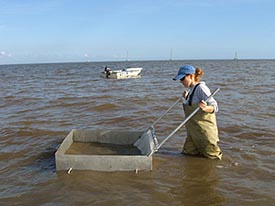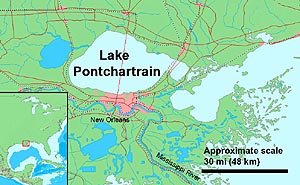Student Features
After Katrina, a Story of Survival and Science
05.02.07
|
Who Are NASA's Earth Explorers? The elementary school student wondering how El Niño will affect tomorrow's weather. The scientist studying connections between ozone and climate change. And the farmer using satellite pictures to keep track of crops. All of these people are Earth Explorers -- they are all curious about the Earth system. This monthly series will introduce you to NASA Earth Explorers, young and old, with many backgrounds and interests. Nominate an Earth Explorer! Tell us about the Earth Explorers you know. We're looking for students, teachers, scientists and others who are working with NASA Earth science data and imagery to better understand our home planet. Send your nominations to Dan Stillman: dan_stillman@strategies.org. |

|
Image to right: Lissa Lyncker is studying the effects of Hurricane Katrina on the blue crab population of Lake Pontchartrain. Credit: NASA
Lyncker grew up in Irish Bayou, a small fishing community along the lake's southeastern shore. Most of her family members are fishermen. They depend on the lake for shrimp, crab and other seafood.
Lyncker is a graduate student at the University of New Orleans. Pontchartrain is as much a part of her life as it's ever been. The lake is where she spends a lot of her time as a student. She travels by boat in search of blue crabs.
Why is Lyncker interested in blue crabs? They are an important link in the lake's natural food chain. They are also important to Louisiana's economy. People all over the country eat seafood that comes from Louisiana. Blue crabs bring a lot of money into the state.
Lyncker studies seasonal changes in the number and location of young blue crabs. This information is used by people who plan projects to keep Pontchartrain healthy. These projects improve water quality in the lake. The efforts also increase the number of blue crabs and other species.
There's more to Lyncker's research than just finding and counting blue crabs. She also tries to learn how and why the crabs end up where they do. To do this, she looks at satellite images that show tides and currents. In the satellite images, moving water shows up brighter than the rest of the lake. Both tides and currents can be seen in images of the lake taken by the Moderate Resolution Imaging Spectroradiometer, or MODIS, an instrument on board NASA's Terra and Aqua satellites.
| Related Resources + MODIS + Oceanworld: Fisheries + Previous Earth Explorers Articles |
Lyncker enjoys studying blue crabs and Pontchartrain. Sometimes, though, she can’t help but think about how the lake has changed her life and the lives of many others.
In August 2005, Katrina postponed Lyncker's research. As the hurricane approached, she helped her family prepare. They boarded up windows, tied down boats and secured crab traps. They also carried freezers full of crabs upstairs to avoid the potential floodwaters. A day before Katrina hit, they drove north to Columbus, Miss., where they stayed with friends. They watched TV for news from home.
The news wasn't good. Pontchartrain had spilled over into New Orleans and nearby areas. A lot of houses were destroyed, including many belonging to Lyncker's family. Lyncker and her mom were lucky. Incredibly, their house was still standing.

|
Image to left: Lake Pontchartrain is the second-largest body of salt water in the United States. Credit: Wikimedia
After a couple of weeks in Mississippi, Lyncker and her family returned to Louisiana. For a time, they lived off of water and meals-ready-to-eat, which are food packets provided by the military. School and research would have to wait for Lyncker. She and the rest of southeast Louisiana had to clean up and start over.
For Lyncker and her mom, the first step was to visit their house. There was a lot of damage to the outside of the house. There was also the smell of spoiled crabs. "All the freezers inside had thawed, and the soft-shell crabs were rotting," Lyncker said. "The smell was putrid."
It's now been more than 19 months since Katrina. Still, many in Lyncker's family are without homes. Some live with Lyncker and her mom. All of them are working to put their lives back together. Meanwhile, Lyncker is again exploring Pontchartrain’s blue crabs. She's been delayed, but not discouraged.
"I guess I had a six-month-or-so setback. I could have probably graduated last semester or last summer had Katrina not hit. But I'm OK with my situation," she said. "I came back to New Orleans and began again just like everyone else. What else could we do?"